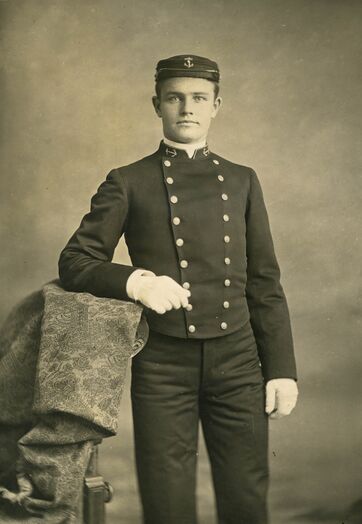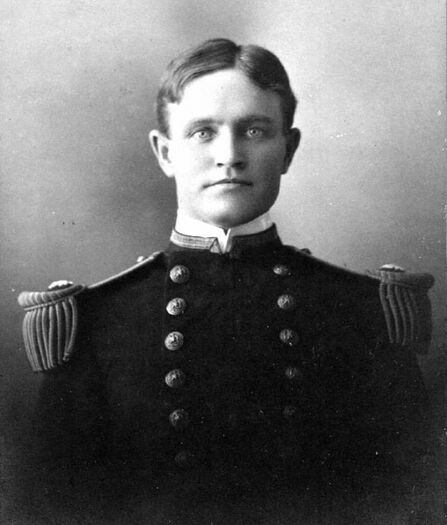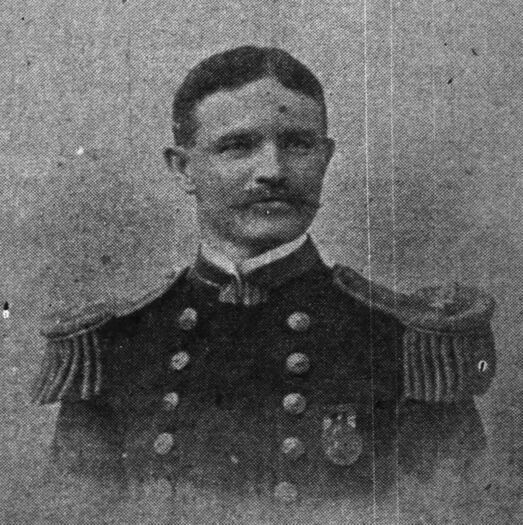WILLIAM C. DAVIDSON, LT, USN
William Davidson '95
Lucky Bag
From the 1895 Lucky Bag:
Davidson
Sioux City, Iowa
Navy Football Team, 1893, 1894. Chapel Choir. Class Football Team, 1893, 1894.
Davidson
Sioux City, Iowa
Navy Football Team, 1893, 1894. Chapel Choir. Class Football Team, 1893, 1894.
Photographs
Loss
William was lost on April 13, 1904 when the port 12" gun in the aft turret aboard Missouri (Battleship No. 11) flared backwards, ignited three propellant charges, and started a fire. Thirty-five others were also lost.
Other Information
From Chicago Academy of Sciences / Peggy Notebaert Nature Museum:
William Christopher Davidson was a graduate of the United States Naval Academy at Annapolis. A native of Indiana, he was appointed a midshipman from South Dakota in 1891. He graduated from the academy in 1895 and was then given duty with the, then new, cruiser, the U.S.S. Olympia. He served on that ship from 1895-1897.
In 1897 he was given the rank of ensign and assigned to the U.S.S. Concord, where he served during the Spanish American War. He was present on that ship during the historic Battle of Manila Bay, in 1898, which gave the United States control over the Philippine Islands. He was cited specifically in reports made by the commanding officer, Commander Asa Walker and Lieut. Commander G.P. Colvocoresses, for performing his duties well.
He continued his military service in the navy until his untimely death in 1904. He was promoted to the rank of Lieutenant (junior grade) on July 1, 1900 and to Lieutenant on June 18, 1902. While serving on the U.S.S. Missouri (BB-11) during target practice the gun turret in which he was working caught on fire and the ammunition stored near the turret caused an explosion that killed Davidson and 35 other officers and crew. This accident caused a review of the arrangements on naval ships of ammunition storage that greatly reduced the number of future accidents of this type. He had also served on the U.S.S. Brooklyn, U.S.S. Monocacy, U.S.S. Alliance, U.S.S. Franklin and the torpedo station at Newport, Rhode Island. He left behind a wife, Juliet L. Davidson.
From a speech at the dedication of the memorial cannon in his name:
Lieut. William Christopher Davidson, the only son of Mr. and Mrs. Andrew Jackson Davidson, of Sioux City, was born near Rochester, Ind., on the 22d day of July 1872. Three years later his parents moved to St. Elmo, Ill., where they lived until their son was 11 years of age, when they again moved westward, this time locating near Chamberlain, S.D., whence they moved to Sioux City in 1889. When a youth Lieut. Davidson was a good student and soon after his parents came to Sioux City they sent him to the state agricultural college at Brookings, S.D., where during the spring term of his second year he successfully passed the preliminary examination for admission to the United States naval academy at Annapolis, received his appointment from Congressman Pickler and became one of the ninety-seven cadets who in 1891 entered the naval academy, and four years later, upon graduation, he stood third in the class. At the academy Lieut. Davidson was a social favorite as well as an excellent student and was a member of their baseball and football teams, playing halfback on the famous team of 1893.
Prior to his graduation he with seven of his classmates requested that they be ordered to serve their two years as cadets upon the cruiser Olympia, which had recently been put in commission. Their request being granted, Lieut. Davidson was ordered to report for duty to the commander of the Olympia at Mare Island, California, whereupon he was assigned to the duty of assistant navigator on the Olympia, which cruised for two years upon the Pacific, visiting the Hawaiian islands, Japan, China, Korea, and Siberia. Upon arriving at Yokohama they found the Americans on shore very much wrought up over the defeat of the local and naval American baseball teams by the Japanese students at Tokio. It remained for the Olympia's team to redeem the national honor, which they did at Tokio by a score of 14 to 12 on the 4th day of July, 1896.
A few weeks after the Olympia's return to the United States Lieut. Davidson was married at Baltimore on June 1 1897, to Miss Juliette LeRoux, the beautiful and only daughter of Prof, and Mrs. Julius LeRoux, of Annapolis, Prof. LeRoux having been professor of languages at the naval academy for thirty years.
After the wedding trip, during which Lieut. and Mrs. Davidson visited his parents in this city Lieut. Davidson was ordered to report for duty on board the gunboat Concord at Mare island. The Concord cruised upon Alaskan waters from the last of June until January 7, 1898, when she was ordered to join the Asiatic squadron at Yokohama under command of Commodore George Dewey
During the blockade of Manilla bay and the capture of the city of Manilla Lieut. Davidson participated in a number of engagements, among which were the capture of the ports and fortifications at Vitas outlet, Caloocan and Isle Grand. For conduct during these actions Lieut. Davidson received honorable mention twice from his admiral and was personally commended for bravery and efficiency by the secretary of the navy, and was advanced from the rank of ensign to that of lieutenant. Upon leaving the Paragua he was given the command of a company of marines and several rapid fire guns, with which he stormed and captured a number of fortified villages and destroyed many insurgent vessels which had taken refuge in the rivers. A little later, owing to the illness of its commander, Lieut. Davidson was given the command of the gunboat Paragua with which he participated in a number of coast engagements
The limited time afforded permits me to give the details of but one of the engagements in which Lieut. Davidson participated while in command of the gunboats and I have chosen the bombardment and capture of Romblon for the reason that there this old bronze cannon was taken. Romblon is situated in a low valley with a very narrow harbor and high hills all around, where a small force could easily keep off an army. On the early morning of December 16 the Concord, Paragua and a transport for two companies of the Eighteenth infantry approached the narrow harbor. Everything was silent and motionless noon the shore except the rebel flag which floated lazily from the fort upon the highest hill. A landing force entered the boat under the command or Lieut. Davidson and approached within the distance of 800 yards from the shore, when, a fierce fire opened upon them from all sides, killing and wounding a number of our men. The boat swerved from the firing line of the Concord and while the 6-inch shell from the gunboat shrieked by, our men, firing in response to the enemy, kept steadily on until they reached the beach, then forming quickly they advanced, cheering as they charged upon the fort. After a hard climb and a short, fierce fight the fort was captured. Its position commanded the town and our men, charging in squads over the hills, soon drove the enemy out.
As I recall the story of the capture of the cannon as told by Lieut. Davidson, it was mounted upon the shore below the fort at Romblom. In a letter to his parents dated December 17, the day after the fight, Lieut. Davidson wrote: "On shore I found a small bronze cannon weighing about 70 pounds. It is very old and as a cannon it is useless, but as a relic it is valuable. My plan is to present it to Sioux City."
The war in the Philippines being practically over, and his required service upon the Pacific having been completed, Lieut. Davidson was ordered home for duties, but while at Japan on his way home the Chinese war broke out and he volunteered to report for duty in China. The commander of the Brooklyn requested that Lieut. Davidson go with him. saying, "There may be trouble and I will need Davidson." And so he proceeded to China upon the Brooklyn in command of ninety bluejackets, two 3-inch guns and two Colt's automatic guns.
When the mint of Li Hung Chang was discovered Lieut. Davidson was temporarily placed in charge of the same, whereupon he put a stop to the looting of the mint and turned over to the authorities about twenty tons of silver bullion. When the war came to an end Lieut. Davidson was ordered home, where, after a short time, he was detailed for duty upon the training ship Alliance, which cruised for about three years upon the Atlantic, visiting England, Gibraltar and the West Indies.
In the late summer 1903 Lieut. Davidson was ordered to report for duty with the North Atlantic squadron and participated in the naval maneuvers of that year and was advanced to the rank of senior lieutenant. In the late fall of 1903 he returned home upon a short vacation, visiting his parents at Sioux City, as he had done during each of his vacations, and while in Sioux City he received orders to report for duty upon the Missouri, which was about to go into commission at the Norfolk navy yard.
Lieut. Davidson had the honor of being chosen umpire for the Kearsage when her gunners made the world's record. During the noon hour on April 14 the Missouri was engaged in target practice, and Lieut. Davidson, in charge of the after twelve-inch turret, fired a number of shots, making most satisfactory marks, when the charges then being put in the gun caught fire. How this happened will probably never be known, but it Is believed to have been caused by the gases in the gun from the previous shot. The court of inquiry designated it as a flashback. The burning powder dropped below into the handling room, igniting eight other sections of smokeless powder which resulted in the death of every man in the turret. The court of inquiry found that the accident was in no respect due to fault or negligence on the part of any of the officers or members of the crew.
William S. Cowles. captain of the Missouri, who talked with Lieut. Davidson in the turret a few moments before the accident, in a personal letter to the family of Lieut. Davidson, said: "His loss is a great one to the service. He died at the post of duty in the faithful and intelligent discharge of his duties." It is indeed consoling and lessens the pain to his parents and wife to learn from him who was first to reach Lieut. Davidson's side and from other officers on the Missouri that his death was instantaneous and that in the moment of time, during which the burning powder dropped below, when any one might think of self preservation, "our Davy" commended his men and stood aside to allow them to seek safety first from that awful tomb of fire. This is indeed the grandest and most heroic act of an officer, and he will pass into history as one of the heroes of the American navy.
I want also to tell you something about Lieut. Davidson's personal characteristics and something of "Davy," as his friends knew him. My allotted time will afford but the briefest statements, he was in deed and in fact a loving son, a devoted husband, a stanch friend, modest but manly, a generous and good companion, considerate of others, but never sparing himself, a hard student, a scholarly writer, a master of languages, an expert in mechanics, a brave, faithful and efficient officer and a noble man. There was something about his strong and kindly face that commanded respect and confidence, and to know him well was to become his devoted friend. There is a custom, contrary to regulations in the navy, that when a commanding officer is relieved from the command of a ship, if he is popular, for the crew to get together and cheer him; if he Is not popular everything remains quiet. When Lieut. Davidson left the Paragua the entire crew lined up at the gangway that they might shake hands with him and say goodby, and as the boat shoved off they all cheered until he was aboard the Concord and hidden from their sight. He was called a fighter in the navy, yet he had no occasion to punish any of his men. They always felt that they had his confidence and they showed that he had their confidence and respect.
William's diary is described as such:
It encompasses the impressions made on Davidson as he made his first voyage after his graduation from Annapolis and joined the crew of the U.S.S. Olympia as a part of the Asiatic Squadron. The time he spent on this vessel predates the Spanish-American War and was part of a goodwill effort on the part of the United States toward Asian countries, specifically Russia, Japan, and China.
From researcher Kathy Franz:
William's father Andrew was a cattle broker and farmer. William's wife Juliette was the daughter of Professor Jules Leroux of the Naval Academy language department. She remarried and had a daughter.
His funeral was held in Baltimore, Maryland, near where he is buried.
The "Register of Commissioned and Warrant Officers of the United States Navy and Marine Corps" was published annually from 1815 through at least the 1970s; it provided rank, command or station, and occasionally billet until the beginning of World War II when command/station was no longer included. Scanned copies were reviewed and data entered from the mid-1840s through 1922, when more-frequent Navy Directories were available.
The Navy Directory was a publication that provided information on the command, billet, and rank of every active and retired naval officer. Single editions have been found online from January 1915 and March 1918, and then from three to six editions per year from 1923 through 1940; the final edition is from April 1941.
The entries in both series of documents are sometimes cryptic and confusing. They are often inconsistent, even within an edition, with the name of commands; this is especially true for aviation squadrons in the 1920s and early 1930s.
Alumni listed at the same command may or may not have had significant interactions; they could have shared a stateroom or workspace, stood many hours of watch together, or, especially at the larger commands, they might not have known each other at all. The information provides the opportunity to draw connections that are otherwise invisible, though, and gives a fuller view of the professional experiences of these alumni in Memorial Hall.
January 1898
January 1899
January 1900
January 1901
January 1902
January 1903
January 1904
Memorials
During a Memorial Day event in 1904 a "memorial cannon" was placed in Children's Park in Sioux City to remember William.
Related Articles
Ernest Weichert '99, Thomas Ward, Jr. '03, and William Neumann '03 were also lost in this incident.
Memorial Hall Error
William is not included with his classmates in Memorial Hall. This omission was revealed by a mention of his loss in the May 1957 issue of Shipmate.
William is one of 5 members of the Class of 1895 on Virtual Memorial Hall.

The "category" links below lead to lists of related Honorees; use them to explore further the service and sacrifice of alumni in Memorial Hall.


